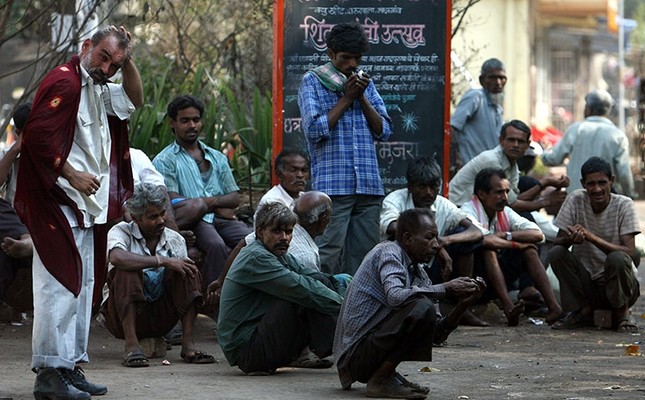India’s labour market is ailing. It has been for some time. And now the nation’s brewing employment woes are impeding the nation’s economic growth.
A growth first to a good jobs strategy
The relentless pursuit of economic growth and the assumption that growth will inevitably lead to more, and eventually better jobs, has all but proven to be unfounded. For almost a decade, India’s economic growth has neither produced enough jobs, nor the quality of jobs, that the nation needs. Capital intensification fuelled economic growth for several consecutive years, but it did not generate enough employment to absorb the country’s surplus labour depressing wages and working conditions. A lack of productive jobs and low wages are now manifesting in a decline in private consumption and low aggregate demand. This in-turn adversely affects production and investment creating a viscous cycle.
Breaking this cycle calls for a drastic shift in priorities from a growth first narrative to a good jobs first strategy.
More and better employment must be the priority. Harnessing the productive potential of the nation’s population (especially it`s large and growing youth population) through good jobs will drive more sustainable economic growth. This, on the one hand, entails focusing on the expansion of labour intensive sectors, especially in manufacturing and infrastructure, to create more jobs; on the other, it entails investing in effective education, skills and social protection for workers.
Drop in female labour force
Only one in two Indians of working age, 15 years and above, participate in the labour force. Fewer than one in four women 15 years and above – 23.3 percent – enter the labour market, and this rate has been declining in recent years. The drop in female labour force participation can be attributed to several factors ranging, for instance, from girls staying in education longer and delaying their entry into the labour market, to the ‘middle income effect’. A lack of demand from female friendly industries such as apparel and footwear, and continuing social disapproval of women’s economic engagement are both important factors. Other culprits include migration and the nuclearisation of families where there are fewer women in the household to contribute to domestic work. Women also tend to be relegated to low-value added activities; they receive lower wages, and are more likely to be exposed to various forms of exploitation than their male counterparts, such that staying at home becomes a more appealing option.
India’s unemployment rate now stands at 6.1 percent, up from 2.2 percent in 2011-12. At 17.8 percent, the youth unemployment rate is nearly three times that of the general labour force, up from 6.7 percent in 2011-12. The rise in unemployment can largely be explained by the fact that more young people are obtaining an education. Equipped with education, some youth expect a ‘better’ job. Those who can afford education also tend to be in a position to wait for a job that meets their requirements. Those who are not as financially fortunate must find the means to make a living, however poor in quality the work may be.
Mismatch between education and labour market
In addition to more educated young people waiting for the right job to come along, evidence also points to a mismatch between education and labour market demand. The India Skill Report 2018 highlights the fact that higher unemployment among the educated signals the disconnect between skills and aptitude of a majority of graduates, and the needs of industry. In a survey of 416 employed youth in Sonipat and Faridabad districts of Haryana, the JustJobs Network found that 56 percent of employed respondents felt that their general education and their vocational skills were insufficient to help them procure a job.
Aside from the uptick in unemployment, underemployment is also a worrying phenomenon. Most people in India cannot afford to be unemployed; they have to work to sustain themselves. Among those that are working, informal employment as a share of non-agricultural employment was 68.4 percent. Informal employment usually entails the sharing of low-productivity work, with poor wages, and the absence of social protection.
What’s more, regular wage and salaried work is also becoming increasingly precarious. The share of regular wage workers with a written contract went from 59.1 percent in 2004 to 71.1 percent in 2018. Thirty-eight percent of regular wage/salaried workers were not eligible for paid leave, did not have a written job contract and were without any social security benefits in 2018.
On the heels of these indicators reflecting poor labour market health, economic growth has also slowed down from eight percent in the first quarter of fiscal year 2018 to five percent for the same period this year.
When it comes to job creation, the composition of growth matters. India must prioritise labour intensive over capital intensive sectors. Mega investment in sunrise and advanced technology may invite some investment from global companies, but much more — from streamlining company compliances to improving access to finance — can help domestic labour intensive firms, especially in manufacturing sectors, grow. Small firms in these sectors offer the potential to become engines of job growth.
Infrastructure development creates large numbers of jobs – though the quality of construction jobs leaves much to be desired. The multiplier effect of infrastructure projects can be significant from promoting value chains, connecting production to markets, building irrigation, energy and transportation infrastructure for rural areas to alter cropping patterns toward more labour intensive and higher value crops. All these are promising potential outcomes of investments in infrastructure, but building infrastructure needs resources and institutions to deliver projects successfully.
The need for more and better jobs is one side of the equation. The other side is creating a labour force that has the requisite education and skills to meet the needs of the labour market today, but that is also adaptable in the face of a technologically driven, dynamic 21st century economy. To this end, it is imperative to build a strong foundation with quality basic education for all as a precursor to skills development. Skills development cannot compensate for deficiencies in education.
In addition to investing in education and skills, there is a need to rethink social protection in an era of growing labour market precarity. As the Indian government simplifies and rationalises the existing labyrinth of labour regulations, it must heed the warning that the poor labour market indicators are delivering. The rules for the minimum wage code must be clear so as to ensure that workers are making enough to provide for themselves and their families. The code on occupational safety and health must be implemented to ensure that workers are well protected in their workplaces. The right and ability to organise must be secured to ensure an effective channel for industrial relations. And the social security code must move toward greater universalisation of benefits to account for the growing precarity in the labour market.
The country needs a comprehensive and coherent roadmap for just jobs. Only then will we spur aggregate demand to jumpstart flagging economic growth. Only then can we break the vicious cycle we are in and make way for a virtuous cycle of rising living standards for all.


 [/column]
[/column]